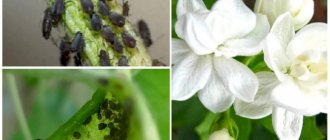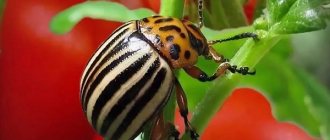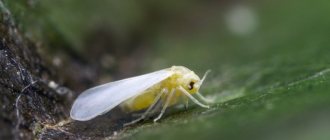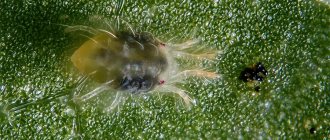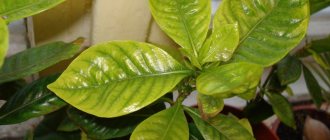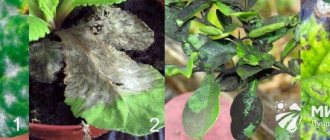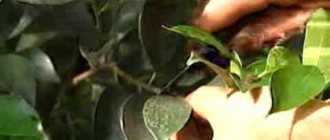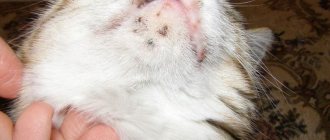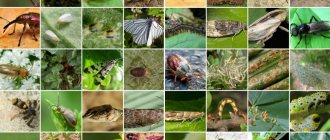If you carefully read our article about caring for Balsam, most likely your pet will not get sick. But it’s not always possible to take perfect care of your flower, because summer has come - it’s time for vacations. What should you do if you were away from home for a long time, and upon arrival you discovered that your Balsam was sick? Read the next article, in which we will talk about how to deal with diseases and pests of indoor Balsam.
Common ailments, their treatment and photos
Gray rot
This is a fungal disease. It is characterized by the appearance of brown spots on stems and leaves. If measures are not taken in time, the flower will die.
Causes:
- hypothermia;
- watering with cold water;
- drafts;
- low air temperature;
- soil contamination with spores of pathogenic fungi.
Treatment:
- The affected parts of the plant are cut off with a sterile instrument to healthy tissue.
- The healthy part is sprayed with Fundazol from a spray bottle. Fundazol is a systemic fungicide with a broad spectrum of action. Preparation of the solution: dilute 1 g of powder with 1 liter of water, stir until completely dissolved. Spraying is carried out carefully; all above-ground parts of the plant must be treated.
- The indoor flower is transplanted into a pot with new soil. Before planting, the soil is also sprayed with a solution of Fundazol. The drug is diluted in the same proportion. Once in the soil, the fungicide prevents the development of pathogenic fungi.
Before the procedure, the instrument (scissors or pruning shears) should be kept in medical alcohol, and the sections should be sprinkled with charcoal powder or cinnamon.
Bacteriosis
It appears as watery spots that quickly enlarge and acquire a brown tint.
Causes:
- contaminated soil;
- dirty tools;
- excess moisture or fertilizer.
Treatment:
- Pruning diseased parts of the plant.
- Spraying with copper oxychloride (CHOM). This is a fungicidal preparation with protective contact action. The solution is prepared in the following proportion: 4 g of powder per 10 liters of water. Then carefully spray the plant from all sides with a spray bottle.
- After 14 days, the procedure is repeated.
- The soil should also be sprayed with the same solution.
Powdery mildew
The disease is characterized by the appearance of a white coating on all parts of the plant, curling and drying of the leaves (read about why balsam leaves can hurt here, and about why leaves can turn yellow, read here).
Causes:
- improper watering;
- air stagnation;
- low temperature;
- bad light.
Treatment:
- Removing diseased parts of the plant.
- Spraying with soda ash solution. To do this, dissolve 1 tablespoon of soda in 5 liters of water, add 2 tablespoons of liquid soap. Thoroughly spray the plant with this solution using a spray bottle.
- The procedure is repeated after 10 days.
- As an alternative, you can use a copper-soap solution. To do this: 5 g of copper sulfate is dissolved in 250 ml of hot water. Separately prepare a soap solution: 50g of soap is grated and dissolved in 5 liters of warm water. Then a solution with vitriol is poured into it. The plant is sprayed with this emulsion from a spray bottle.
Mosaic disease
It is characterized by the appearance of spots on the leaves, followed by their drying out and falling off. Flowers and buds also fall off.
The disease is viral in origin and is fatal to balsam. The mosaic virus is spread by thrips (parasitic insects) and cannot be treated.
The diseased plant should be destroyed and the soil should be thrown out of the pot.
You will find a list of the main diseases of balsam in our material.
Physical wrestling
This concept means, first of all, the creation of favorable conditions for the development of plants: watering, killing weeds. For indoor plants, temperature is of great importance.
We suggest you read: Fighting yellowing of eggplant seedlings
The first single affected plants must be removed immediately. Destroy torn out damaged leaves or shoots, do not just leave them on the ground - this is a breeding ground for the next generations of the pest.
It would be a good idea to irradiate indoor plants with ultraviolet light: this slows down the reproduction of the parasite.
If the plant dries out
First of all, you should inspect it for the presence of spider mites. If the parasite is present, then this is the cause.
What should be done:
- Trim flowers to reduce strain.
- Lather the sponge with laundry soap and wipe the plant. You should also wipe the pot and tray.
- Rinse the soap thoroughly with running water from the shower.
- After drying, spray the plant with Fitoverim (an insectoacaricide with enteric contact action). To prepare the solution, you need to dissolve 5 g of the drug in 1 liter of water. Spray the flower with a spray bottle. Repeat the procedure after 10 days.
Spider mites are parasites that feed on plant cell sap. As a result, they become weak and susceptible to infections.
If there are no spider mites, then the reasons may be the following:
. In order to solve the problem, you need to spray the flower twice a day.
Dry air- Air temperature . It should not fall below 15 degrees.
- Direct sunlight . First, burns appear, and then the flower dries up.
- Soil quality . If the soil has not been changed for more than a year, it becomes depleted. The flower lacks nutrients.
- Root rotting . Reasons: excessive watering, soil contamination with fungal infections.
- Insufficient watering . The plant suffers from lack of moisture.
Causes of flower death:
- Diseases of fungal, viral and bacterial nature.
- Pests. Thrips, whitefly, spider mites, aphids.
- Improper care: excessive watering (causes root rot), insufficient watering, low temperature combined with high humidity.
Peculiarities
The leaves and stems of balsam are very juicy, that is, their cells contain a lot of water and little dry matter. This is well illustrated by a situation where there has been no watering for a long time: leaves and shoots quickly wither, hang like rags, losing their shape. Leaf turgor directly depends on their moisture saturation.
There is the opposite situation: good watering and high humidity lead to the appearance of small droplets of sweet liquid along the edge of the leaf. It is for this ability that the balsam received the name Vanka wet.
How to reanimate a plant to save it?
What to do if the flower has withered, drooped and darkened at the base and is slowly dying? If the flower dies, urgently do the following:
- Find out the reason.
- Adjust air and soil humidity.
- Trim the affected areas back to healthy tissue.
- Eliminate drafts.
- Avoid exposure to sunlight.
- Spray the flower with fungicide. It is best to use the broad-spectrum drug Discor. To do this, dissolve 1 ml of the drug in 2 liters of water. Spray the plant with the resulting solution from a spray bottle. Repeat procedures after 10–12 days.
Discor is a highly effective chemical fungicide of contact and systemic action. Covers a wide range of diseases. Often used in cases where the plant disease is uncertain.
If the roots are damaged:
- Remove the flower from the pot and carefully free the root from any lumps of soil.
- Rinse the root under running water.
- If there are damaged areas on the root, prune them.
- Prepare a Kornevin solution at the rate of 1 g of powder per 1 liter of water.
- Place the plant there so that only the roots are immersed in the solution.
- After a day, replace the solution with water, place the flower there and leave there until young roots begin to grow.
- After this, the balsam can be transplanted into new soil.
Corevin is a chlorine-free biostimulating drug that promotes the development and restoration of the root system.
The most resistant varieties of balsams
Impatiens form very beautiful inflorescences. Touch-me-not varieties are distinguished by their color and shape.
The most resistant to pests and diseases are the following:
- Camellia Flowered - tall;
- That Thumb, Baby Bush are short;
- Stardust - compact;
- Super Elfin, King Kong - medium height;
- Impatiens walleriana Fiesta - decorative;
- Peach Butterfly - apricot;
- Rainforest Exotic - exotic;
- Jangle Rain – bright bronze;
- Accent Salmon – single color.
Professional flower growers advise giving preference to hybrid varieties of balsam.
Why do flowers fall?
There may be several reasons why flowers wither and fall off:
- The soil is too wet . This provokes rotting and death of the roots. In this case, the plant does not receive nutrients from the soil and drops flowers.
- Lack of potassium . Potassium is necessary for good flowering; if the soil is poor, the plant does not have enough strength to flower (this article explains why balsam does not bloom).
- Pests often cause flowers to drop. They suck out plant juices and thereby cause various diseases. After which an infection often occurs.
- Incorrect fertilizing , namely excess nitrogen in the soil. Nitrogen promotes crown development and inhibits flowering.
- Anxiety . Impatiens do not like being moved, turned, or transferred from one room to another. This causes stress and causes the colors to drop.
- Transplantation during flowering . This is strictly prohibited, as the plant is subjected to severe stress and stress.
- Inappropriate soil . The soil for balsam should be slightly acidic, light and loose. This is the only way the plant can fully absorb all nutrients. Otherwise, the flower feels uncomfortable.
Features of indoor balsam foliage
Balsam leaves are soft green, lance-shaped, with jagged edges. With good care, they reach a length of up to 12 centimeters. The leaves contain a large supply of nutrients, which is why they are so fleshy. They also have very high sensitivity. It is by them that almost all plant diseases can be identified.
Vanka wet has a peculiarity - before the rain, drops of juice form on its leaves and branches, and as they evaporate, they crystallize. Because of this, it is called a home rain predictor.
Prevention and proper care at home
Rules of care:
- Impatiens loves diffused light and does not tolerate direct sunlight. Therefore, it is better to place the pot on the eastern or western windowsill.
- Balsam loves abundant watering. It needs to be watered regularly and abundantly, otherwise it will wither, but do not allow the soil to become waterlogged.
- The pot must have holes.
- There must be drainage under the layer of soil in the pot (expanded clay, small stones, etc.).
- In winter, watering is reduced. In winter, water balsam 1-2 times a month.
- The air temperature should not fall below 15 degrees.
- From early spring to late autumn, balsam needs regular feeding. The frequency of feeding is once every 3 weeks.
- The plant should be replanted every spring.
Prevention:
- Regular inspection for diseases and pests.
- Proper care. The room should not be warm, light or humid.
- Once every six months, balsam is sprayed with a solution of Fitosporin for preventive purposes. To do this, ½ teaspoon should be dissolved in 2 liters of water. The resulting solution is sprayed onto the plant from a spray bottle.
Care and prevention are the best way to prevent diseases. If you do everything correctly, you will not have to urgently save your pet from death. Use the above tips, and balsam will delight you with its beauty and lush flowering for a long time.
